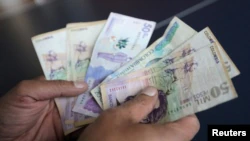Most Latin American currencies closed lower on Wednesday, amid a slight global advance in the dollar and fears for the health of the world economy, with markets attentive to the speech that the president of the Federal Reserve will give in search of of clues about the next movements of the entity.
The dollar rose against a basket of currencies on Wednesday and traded near a 20-year high as investors await Fed chief Jerome Powell’s speech for further clues about the US central bank’s aggressiveness in its fight against inflation.
Investors have scaled back expectations that the Fed might lean towards a slower pace of rate hikes at a time when inflation remains at 8.5% a year, well above the bank’s 2% target.
The dollar index (USD), which measures the performance of the US currency against a basket of six major currencies, rose about 0.1%.
The Mexican peso (MXN) was trading at 19.8846 per dollar at the close, with a gain of 0.19% against the Reuters reference price on Tuesday, after the release of higher-than-expected local inflation figures, which strengthened the expectations that Banco de México will continue to raise its key interest rate.
Mexico’s consumer price index accelerated in the first half of August by 8.62% year-on-year, a level not seen since December 2000. Analysts expected a rate of 8.52%, according to a Reuters poll.
The main stock index S&P/BMV IPC (MXX), which includes the 35 most liquid companies in the Mexican market, fell 1.09% to 47,449.73 units, pending Powell’s speech at the bank’s annual symposium in Jackson Hole.
The Brazilian real (BRL) depreciated 0.23% to 5.1106 units per dollar, while the Bovespa (BVSP) index of the Sao Paulo B3 stock exchange gained 0.12% to 112,991.75 points, mainly supported by the advance of Petrobras (PETR4.SA), in a session of high oil prices abroad and in which new data on deflation in Brazil benefited consumer stocks.
Brazil saw monthly consumer price deflation in mid-August, statistics agency IBGE said, due to tax cuts on key products and as the central bank maintained its aggressive monetary tightening cycle.
In Argentina, the peso (ARS=RASL) fell 0.15% to 137.14/137.15 per dollar in depreciation regulated by the central bank. The Merval stock index (MERV) rose 2.37% to 140,246.05 units, to a closing record, after posting an intraday all-time high of 140,800.07 points. The strength of the ‘ADRs’ on Wall Street were the support in the pace of business.
“Assets rise from the auspicious expectation that the implementation of some cuts in public spending arouses. Making progress on the fiscal front is crucial not only to meet the IMF’s goals but also to improve investor confidence,” he said. a local economist.
The Chilean peso (CLP=CL), (CLP) gave up first-hour gains and closed the day with a drop of 0.23% to 920.80/921.10 units per dollar, in a day of high volatility and despite the injection of foreign currency by the Central Bank. Meanwhile, the leading index of the Santiago Stock Exchange, the IPSA (SPIPSA), rose 0.76% to 5,418.16 points.
The Colombian peso closed with a fall of 1.21% to 4,411 units per dollar, while the benchmark index of the stock market, the MSCI COLCAP (COLCAP), gained 0.19% to 1,291.98 points due to the valuation of shares leaders in the energy sector.
The Peruvian currency, the sol (PEN=PE), (PEN), fell 0.16% to 3.868/3.869 units per dollar. Meanwhile, the benchmark of the Lima Stock Exchange (SPBLPSPT) added 0.31% to 515.88 points.
Connect with the Voice of America! Subscribe to our channel Youtube and turn on notifications, or follow us on social media: Facebook, Twitter and Instagram.












Add Comment